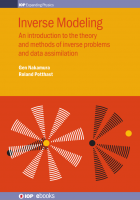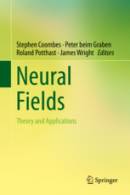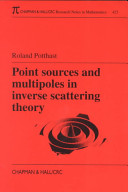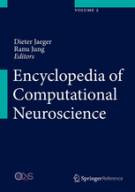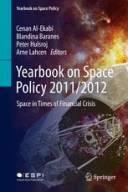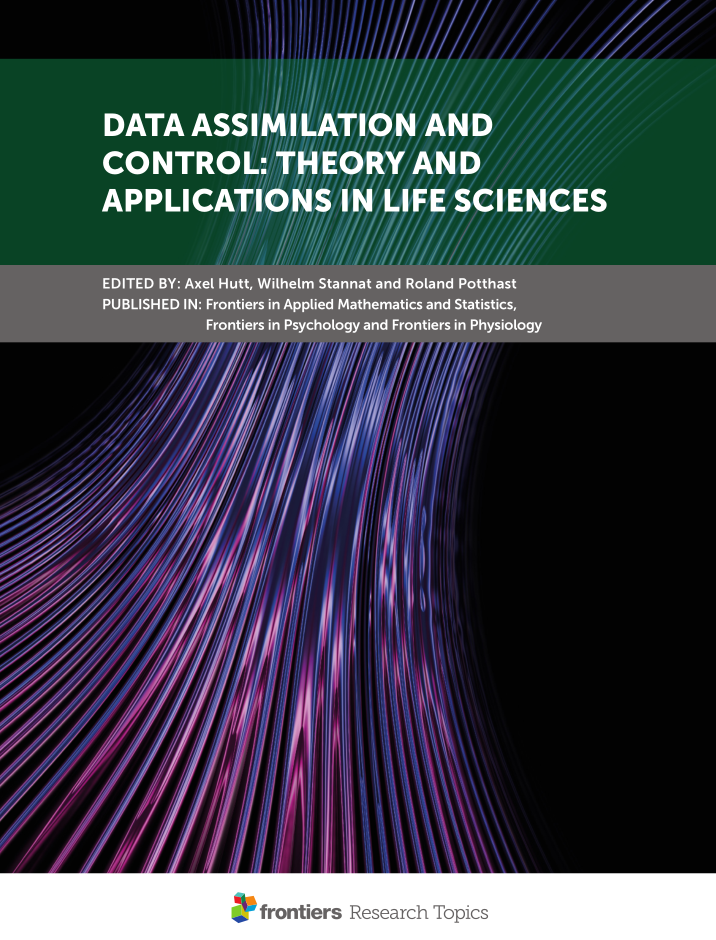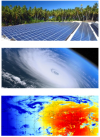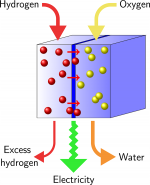[ Welcome ][ Group ][ Research ][ Publications ][ CV ][ MISC ][ My Christian Blog ]
Publications
See also https://mathscinet.ams.org/mathscinet/author?authorId=348650 or R Potthast on Google Scolar or Scopus, ResearcherID: F-2265-2013, compare http://www.researcherid.com/rid/F-2265-2013 or Orcid: http://orcid.org/0000-0001-6794-2500.
Note that citation rates vary by a large factor between disciplines average citation rates.
Books
- Gen Nakamura and Roland Potthast: Inverse Modeling - An introduction to the theory and methods of inverse problems and data assimilation, IOP Ebook Series 2015, 550 pages, 200 images, 170 codes. Book on Amazon ;;;more than 20000 full book downloads!;;;
- Coombes, S., beim Graben, P., Potthast, R., Wright, J. (Eds.): Neural Fields - Theory and Applications. Springer 2014 … ;;;more than 25500 downloads!;;;
Correspondence Courses
Among various lecture notes for basically all my lectures, I have written more elaborate correspondance courses:
- Managers Introduction to Information Technology, Correspondence Course for the Henley Management College, Henley-On-Thames, Oxfordshire, UK (2000).
- Mathematical Foundations of Public Policy, Correspondence Course, University of Erfurt 2002.
More Generic Information on Publishing and Metrics
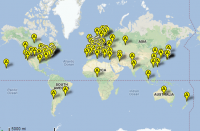
Average citation rates up to 2010 in Mathematics for articles written between 2000 and 2010 1) - meaning that an article written in 2000 has 6.76 citations on average until 2010:
| 2000 | 2001 | 2002 | 2003 | 2004 | 2005 | 2006 | 2007 | 2008 | 2009 | 2010 |
|---|---|---|---|---|---|---|---|---|---|---|
| 6.76 | 6.05 | 5.99 | 5.39 | 4.80 | 4.19 | 3.36 | 2.51 | 1.67 | 0.86 | 0.14 |
leading to an average citation per article of 3.48 in a decade.
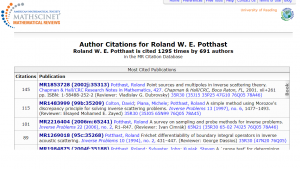 For the full research articles below in 1/2022 around 2635 citations are recorded by Scopus, which
is an average of more than 21 citations per article (121 documents) with an h-index of 26.
Google Scholar records 4803 citations (1689 since 2017),
an h-index of 35 (20 since 2017) and an i10-index of 78 (45 since 2017).
The map on the right indicates the location of institutions
citing the articles. MathSciNet in 01/2022 shows 1295 citations by 691, compare image.
For the full research articles below in 1/2022 around 2635 citations are recorded by Scopus, which
is an average of more than 21 citations per article (121 documents) with an h-index of 26.
Google Scholar records 4803 citations (1689 since 2017),
an h-index of 35 (20 since 2017) and an i10-index of 78 (45 since 2017).
The map on the right indicates the location of institutions
citing the articles. MathSciNet in 01/2022 shows 1295 citations by 691, compare image.
Today, often citation metrics play an important role in judging scientists. But we need to understand that citation counts rather reflect the activity in some layer of science or some particular field rather than the quality of the science of a researcher. In the last years, my work is moving step by step towards enabling scientists to do their work, getting the money in for them to do the research and to shape the programs which enable them to make progress.
Research Journal Papers and Books
2025
- Klaus Vobig, Roland Potthast, and Klaus Stephan: On process-oriented conditional targeted covariance inflation (TCI) for 3D-volume radar data assimilation, Volume 32, issue 4 Nonlinear Processes in Geophysics, 471–488, 2025 https://doi.org/10.5194/npg-32-471-2025
- Wolfgang A. Müller, Stephan Lorenz, Trang V. Pham, Andrea Schneidereit, Renate Brokopf, Victor Brovkin, Nils Brüggemann, Fatemeh Chegini, Dietmar Dommenget, Kristina Fröhlich, Barbara Früh, Veronika Gayler, Helmuth Haak, Stefan Hagemann, Moritz Hanke, Tatiana Ilyina, Johann Jungclaus, Martin Köhler, Peter Korn, Luis Kornblüh, Clarissa Kroll, Julian Krüger, Karel Castro-Morales, Ulrike Niemeier, Holger Pohlmann, Iuliia Polkova, Roland Potthast, Thomas Riddick, Manuel Schlund, Tobias Stacke, Roland Wirth, Dakuan Yu, and Jochem Marotzke, The ICON-based Earth System Model for Climate Predictions and Projections (ICON XPP v1. 0), EGUsphere 2025, Preprint https://doi.org/10.5194/egusphere-2025-2473
- Wolfgang A. Müller, Barbara Früh, Peter Korn, Roland Potthast, et al, ICON: Toward Vertically Integrated Model Configurations for Numerical Weather Prediction, Climate Predictions, and Projections, BAMS 2025, Volume 106, Issue 6, https://doi.org/10.1175/BAMS-D-24-0042.1
2024
- Müller, Wolfgang; Lorenz, Stephan; Pham, Trang Van; Schneidereit, Andrea; Brokopf, Renate; Brovkin, Victor; Brüggemann, Nils; Castro-Morales, Karel; Chegini, Fatemeh; Dommenget, Dietmar; Engels, Frederik; Fröhlich, Kristina; Früh, Barbara; Gayler, Veronika; Haak, Helmuth; Hagemann, Stefan; Hanke, Moritz; Ilyina, Tatiana; Jungclaus, Johann; Köhler, Martin; Korn, Peter; Kornblueh, Luis; Kroll, Clarissa; Krüger, Julian; Nabel, Julia; Niemeier, Ulrike; Potthast, Roland; Riddick, Thomas; Pohlmann, Holger; Polkova, Iuliia; Riddick, Thomas; Schlund, Manuel; Schnur, Reiner; Sgoff, Christine; Stacke, Tobias; Wirth, Roland; Yu, Dakuan; Zaehle, Sönke; Marotzke, Jochem, ICON-XPP Source Code, 2025 https://edmond.mpg.de/dataset.xhtml?persistentId=doi:10.17617/3.UUIIZ8
- Klaus Vobig, Roland Potthast, and Klaus Stephan: On Process-Oriented Conditional Targeted Covariance Inflation (TCI) for 3D-Volume Radar Data Assimilation, EGUsphere, 2024 doi 10.5194/egusphere-2024-2876 Preprint
- JD Keller, R Potthast, AI-based data assimilation: Learning the functional of analysis estimation, arXiv preprint https://arxiv.org/abs/2406.00390
- Amalia Iriza Burca, Rodica C. Dumitrache, Bogdan A. Maco, Mihaita Hustiu, Felix Fundel, Daniel Rieger, Roland Potthast: Comparison of COSMO and ICON-LAM High-resolution Numerical Forecast for Romanian Territory: Case Studies and Evaluation, Atmosfera 2024. https://doi.org/10.20937/ATM.53305
- Iris Ehlert, Sabine Attinger, Hendryk Bockelmann, Georg Feulner, Sabine Grießbach, Corinna Hoose, Thomas Jung, Stefan Kollet, Roland Potthast, Kira Rehfeld, Hauke Schmidt, Ina Tegen, Sönke Zaehle, Jochem Marotzke, Anja Schmidt: natESM white paper: Uniting Earth System Modeling for a Sustainable Future, May 17, 2024, natESM Publication PDF
2023
- Dan Crisan, Oana Lang, Alexander Lobbe, Peter Jan Van Leeuwen and Roland Potthast, Noise calibration for the stochastic rotating shallow water model, Foundations of Data Science, accepted, https://arxiv.org/abs/2305.03548
- Baur, F., Scheck, L., Stumpf, C., Köpken-Watts, C., and Potthast, R.: A neural network-based method for generating synthetic 1.6 μm near-infrared satellite images, EGUsphere accepted, https://doi.org/10.5194/egusphere-2023-353, 2023.
- Jannik Wilhelm, Kathrin Wapler, Ulrich Blahak, Roland Potthast, Michael Kunz: Statistical relevance of meteorological ambient conditions for nowcasting the life cycle of convective storms, QJRMS https://doi.org/10.1002/qj.4505
- Anne Walter, Nora Schenk, Peter-Jan van Leeuwen, Roland Potthast: Particle Filtering and Gaussian Mixtures - On a Localized Mixture Coefficients Particle Filter (LMCPF) for global NWP, J. Meteor. Soc. Japan, 101 https://doi.org/10.2151/jmsj.2023-015 https://arxiv.org/abs/2206.07433
- Maria Reinhardt, Sybille Y. Schoger, Frederik Kurzrock, Roland Potthast: Convective-scale Assimilation of Cloud Cover from Photographs using a Machine Learning Forward Operator, Artificial Intelligence for the Earth Systems (AMS) 2023 https://doi.org/10.1175/AIES-D-22-0025.1.
2022
- Kotsuki, S., Miyoshi, T., Kondo K., and Potthast R. (2022): A Local Particle Filter and Its Gaussian Mixture Extension Implemented with Minor Modifications to the LETKF. Geosci. Model Dev., (in print) https://gmd.copernicus.org/preprints/gmd-2022-69/
- Oana Lang, Peter Jan van Leeuwen, Dan Crisan and Roland Potthast: Bayesian Inference for Fluid Dynamics: A Case Study for the Stochastic Rotating Shallow Water Model, Frontiers in Applied Mathematics and Statistics, accepted. https://arxiv.org/abs/2112.15216 pdf Web
- Takashi Furuya and Roland Potthast: Inverse medium scattering problems with Kalman filter techniques“, Inverse Problems 2022. https://iopscience.iop.org/article/10.1088/1361-6420/ac836f
- Nora Schenk, Anne Walter und Roland Potthast: On Two Localized Particle Filter Methods for Lorenz 1963 and 1996 Models, Frontiers in Applied Mathematics and Statistics, section Dynamical Systems, 2022, https://www.frontiersin.org/articles/10.3389/fams.2022.920186/abstract.
- Christine Sgoff, Walter Acevedo, Zoi Paschalidi, Sven Ulbrich, Elisabeth Bauernschubert, Thomas Kratzsch, Roland Potthast: Assimilation of crowd-sourced surface observations over Germany into a Regional Weather Prediction System, QJRMS, 2022, https://rmets.onlinelibrary.wiley.com/doi/full/10.1002/qj.4276
- Roland Potthast, Klaus Vobig, Ulrich Blahak, Clemens Simmer: Data Assimilation of Nowcasted Observations, MWR, 2022, https://doi.org/10.1175/MWR-D-21-0017.1.
- World Bank. ICON-In-the-Cloud (ICONIC) : Piloting Numerical Weather Prediction on Commercial Cloud Services for Central Asia (English). Washington, D.C. : World Bank Group. PDF
2021
- Bastian Harrach, Tim Jahn, Roland Potthast: Regularising linear inverse problems under unknown non-Gaussian white noise allowing repeated measurements, IMA Journal on Numerical Analysis 2021, accepted. https://arxiv.org/abs/2010.04519 https://doi.org/10.1093/imanum/drab098
- Klaus Vobig, Klaus Stephan, Ulrich Blahak, Kobra Khosravian, Roland Potthast: Targeted Covariance Inflation for 3D-Volume RADAR Reflectivity Assimilation with the LETKF”, QJRMS 2021. Web
- Silke Trömel, Christian Chwala, Carina Furusho, Cintia Carbajal Henken, Julius Polz, Roland Potthast, Ricardo Reinoso-Rondinel, and Clemens Simmer: Near-Realtime Quantitative Precipitation Estimation and Prediction (RealPEP), BAMS 2021. https://doi.org/10.1175/BAMS-D-21-0073.1
- Yi-Hsuan Lin, Gen Nakamura, Roland Potthast, Haibing Wang: Duality between range and no-response tests and its application for inverse problems, Inverse Problems and Imaging, 2021. PDF
- J. Otkin, R. Potthast and A. Lawless: Nonlinear Conditional Model Bias Estimation for Data Assimilation, SIADS 2021. PDF
- A. Hutt, M. Bocquet, A. Carrassi, L. Lei and R. Potthast: Data Assimilation of Nonlocal Observations in Complex Systems, Editorial, Front. Appl. Math. Stat., 28 May 2021 | https://doi.org/10.3389/fams.2021.658272, Web
2020
- R. Potthast: Ensemble Data Assimilation for Estimating Analysis Uncertainty, Book Chapter in Haraldur Olafsson Jian-Wen Bao (Editors): “Uncertainties in Numerical Weather Prediction” Book Webpage https://doi.org/10.1016/B978-0-12-815491-5.00006-9
- C. Sgoff, A. Schomburg, J. Schmidli, R. Potthast: Assimilating satellite-derived land surface temperature in a coupled land-atmosphere model, QJRMS PDF.
- Frank Kaspar, Deborah Niermann, Michael Borsche, Stephanie Fiedler, Jan Keller, Roland Potthast, Thomas Rösch, Thomas Spangehl, Birger Tinz: Regional reanalysis at Deutscher Wetterdienst: Review of evaluation results and application examples, Advances in Science and Research, PDF.
- B. von Harrach, T. Jahn and R. Potthast: Beyond the Bakushinkii veto: Regularising linear inverse problems without knowing the noise distribution, 2020, Numerische Mathematik. PDF, see also https://arxiv.org/abs/1811.06721
- Axel Hutt, C. Schraff, H. Anlauf, L. Bach, M. Baldauf, E. Bauernschubert, A. Cress, R. Faulwetter, F. Fundel, C. Köpken-Watts, H. Reich, A. Schomburg, J. Schröttle, K. Stephan, O. Stiller, M. Weissmann and R. Potthast, Assimilation of SEVIRI Water Vapor Channels With an Ensemble Kalman Filter on the Convective Scale, Front. Earth Sci., 12 March 2020, https://www.frontiersin.org/articles/10.3389/feart.2020.00070/full
- Guergana Guerova, G. MöllerE. Pottiaux, H. Brenot, R. Van Malderen, H. Haralambous, F. Tymvios J. Douša, M. KačmaříkK. Eben, H. Vedel, K. Rannat, R. Kivi, A.-M. Harri, O. Bock, J. F. Mahfouf, J. Wickert, G. Dick, R. Potthast, S. CrewellC. Pikridas, N. Zinas, A. Ganas, R. Szabolcs, M. Mile, S. Thorsteinsson, B. G. Ófeigsson, Y. Reuveni, S. Krichak, R. Pacione, G. Bianco, R. Biondi, G. Stankunavicius, F. N. Teferle, J. Bosy, J. Kaplon, K. Szafranek, R. Fernandes, P. Viterbo, A. SáJ. Hefty, M. H. Igondova, E. Priego, G. Elgered, M. Lindskog, M. Ridal, U. Willén, T. Ning, E. Brockmann, K. Wilgan, A. Geiger, C. Mekik, J. Jones, Z. Liu, B. Chen, C. Wang, S. Masoumi, M. Moore, S. MacPherson (2020): National Status Reports. In: Jones J. et al. (eds) Advanced GNSS Tropospheric Products for Monitoring Severe Weather Events and Climate. Springer, Cham PDF
2019
- Axel Hutt , Wilhelm Stannat and Roland Potthast (Editors): Data Assimilation and Control: Theory and Applications in Life, 2019, Front. Appl. Math. Stat. doi: 10.3389/fams.2019.00025 Web and PDF
- J. Otkin and R. Potthast: Assimilation of All-Sky SEVIRI Infrared Brightness Temperatures in a regional-scale Ensemble Data Assimilation System“, MWR Monthly Weather Review, accepted for publication PDF
- Yves-Marie Saint-Drenan, Stephan Vogt, Sven Killinger, Jamie M.Bright, Rafael Fritz, Roland Potthast: Bayesian parameterisation of a regional photovoltaic model – Application to forecasting, Solar Energy 2019 PDF
- J. Waller, E. Bauernschubert, S.L. Dance, N.K. Nichols, R. Potthast and D. Simonin: Observation error statistics for Doppler Radar radial wind superobservations assimilated into the DWD COSMO-KENDA system, Monthly Weather Review 2019, PDF.
- Peter Jan van Leeuwen Hans R. Künsch Lars Nerger Roland Potthast Sebastian Reich: Particle filters for high‐dimensional geoscience applications: A review, QJRMS 2019 https://rmets.onlinelibrary.wiley.com/doi/abs/10.1002/qj.3551
- Roland Potthast, Anne Walter and Andreas Rhodin: A Localised Adaptive Particle Filter within an Operational NWP Framework. Monthly Weather Review 2018, https://doi.org/10.1175/MWR-D-18-0028.1.
- Meike Hellweg, Jens Nachtigall, Thomas Kratzsch, Roland Potthast, Hella Riede, Zoi Paschalidi, Alexandros Boura, Walter Acevedo, Christoph Stiller. Fleet Weather Map - A Project to Integrate Fleet Data into the Field of Automated Driving. In 2019 Joined Conference and Exhibition of Transportation Association Canada and Intelligent Transportation Systems Canada (TAC-ITSC), September 2019. Web PDF
2018
- Yaodeng Chen, Deming Meng, Hongli Wang, Roland Potthast, Yuanbing Wang, Yufang Gao: The Evaluation of EnVar Method Included Hydrometeors Analysis Variables for Assimilating Cloud Liquid/Ice Water Path on Prediction of Rainfall Events, Atmospheric Research (Elsevier) 2018, accepted for publication.
- N. Udosen and R. Potthast: A framework for solving meta inverse problems: experimental design and application to an acoustic source problem, Modeling Earth Systems and Environment 2018. https://doi.org/10.1007/s40808-018-0541-y
- A. J. Illingworth, D. Cimini, A. Haefele, M. Haeffelin, M. Hervo, S. Kotthaus, U. Löhnert, P. Martinet, I. Mattis, E. J. O’Connor, and R. Potthast: How can Existing Ground-Based Profiling Instruments Improve European Weather Forecasts? BAMS 2018, https://doi.org/10.1175/BAMS-D-17-0231.1.
- Axel Hutt und Roland Potthast: Forecast of spectral features by ensemble data assimilation, Frontiers in Applied Mathematics and Statistics, section Dynamical Systems, 2018. https://doi.org/10.3389/fams.2018.00052
- Roland Potthast und Christian Welzbacher: Ultra Rapid Data Assimilation based on Ensemble Filters, Frontiers in Applied Mathematics and Statistics, 2018. doi.org/10.3389/fams.2018.00045 Web.
- Ndifreke Udosen, Roland Potthast: Automated optimization of electrode locations for electrical resistivity tomography, 2018 Modeling Earth Systems and Environment, pp 1-25; doi:10.1007/s40808-018-0472-7 PDF
- Anthony Illingworth, Ph.D.; Alessandro Battaglia; John Bradford; Mary Forsythe; Paul Joe; Pavlos Kollias; Katie Lean; Maurizio Lori; jean-Francois Mahfouf; Stella Mello; Rolv Midthassel; Yvonne Munro; John Nicol; Roland Potthast; Michael Rennie; Thorwald Stein; Simone Tanelli; Frederic Tridon; Christopher Walden; Mengistu Wolde, WIVERN: A new satellite concept to provide global in-cloud winds, precipitation and cloud properties. BAMS. Accepted. Web PDF
- Frederik Kurzrock, Sylvain Cros, Fabrice Chane-Ming, Jason A. Otkin, Laurent Linguet, Axel Hutt, Gilles Lajoie, Roland Potthast: Cloudy Data Assimilation: A Review of the Use of Cloud-Affected Observations from Geostationary Satellites in Regional-Scale Models, Meteorologische Zeitung, DOI: 10.1127/metz/2018/0904.
2017
- Jason A Otkin; Roland Potthast; Amos Lawless: Nonlinear Bias Correction for Satellite Data Assimilation Using Taylor Series Polynomials MWR-D-17-0171, Monthly Weather Review, accepted. PDF
- Armin Geisinger, Andreas Behrendt, Volker Wulfmeyer, Jens Strohbach, Jochen Förstner, and Roland Potthast: Development and Application of a Backscatter Lidar Forward Operator for Quantitative Validation of Aerosol Dispersion Models and Future Data Assimilation, Atmos. Meas. Tech. Discuss., https://doi.org/10.5194/amt-2017-142, 2017, Revised manuscript accepted for AMT. Previously discussion paper: http://www.atmos-chem-phys-discuss.net/acp-2016-609/
- Aamir Nadeem, Roland Potthast and Andreas Rhodin: On Sequential Multiscale Inversion and Data Assimilation, Journal of Computational and Applied Mathematics (CAM), accepted. PDF
2016
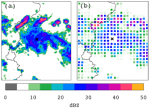
- Christoph Schraff, Hendrik Reich, Andreas Rhodin, Annika Schomburg, Klaus Stephan, Africa Perianez and Roland Potthast: Kilometer Scale Ensemble Data Assimilation for the COSMO Model (KENDA), QJRMS, Volume 142, Issue 696, pages 1453–1472, April 2016 Part A. Abstract Online
- T. Bick, C. Simmer, S. Trömel, K. Wapler, H.-J. Hendricks Franssen, K. Stephan, U. Blahak, C. Schraff, H. Reich, Y. Zeng, R. Potthast: Assimilation of 3D Radar Reflectivities with an Ensemble Kalman Filter on the Convective Scale. QJRMS, Volume 142, Issue 696, pages 1490–1504, April 2016 Part A. PDF Online
- Q.M.Zaigham Zia and Roland Potthast: The Range Test and the No Response Test for Oseen Problems: Theoretical Foundation, Journal of Computational and Applied Mathematics, Volume 304, 1 October 2016, Pages 201–211. Web
- Aamir Nadeem and Roland Potthast: Transformed and Generalized Localization for Ensemble Methods in Data Assimilation, Mathematical Methods in the Applied Sciences, Volume 39, Issue 4, pages 619–634, March 2016. Web
2015
- Gen Nakamura and Roland Potthast: ;;;Inverse Modeling - An introduction to the theory and methods of inverse problems and data assimilation;;;, IOP Ebook Series 2015, 550 pages, 200 images, 170 codes. Web
- Annika Schomburg, Christoph Schraff and Roland Potthast: A concept for the assimilation of cloud information in a Local Ensemble Transform Kalman Filter at the convective scale, QJRMS Volume 141, Issue 688, pages 893–908, April 2015 Part A. Web
2014
- Periáñez, Á., T. H. Reich, and R. W. E. Potthast, 2014: Optimal localization for ensemble Kalman filter systems. J. Meteor. Soc. Japan, 92, 585-597. http://dx.doi.org/10.2151/jmsj.2014-605
- Stephen Coombes, Peter beim Graben, and Roland Potthast: Tutorial on neural field theory, in: “Neural Field Theory”, Springer 2014, Edts: beim Graben, Coombes, Potthast, Wright. weblink Springer
- Peter beim Graben and Roland Potthast: Universal neural field computation, in: “Neural Field Theory”, Springer 2014, Edts: beim Graben, Coombes, Potthast, Wright. weblink Springer
- ;;;”Neural Field Theory“;;;, Springer 2014, Edts: beim Graben, Coombes, Potthast, Wright. weblink Springer
- Roland Potthast: The Amari Model, ;;;Encyclopedia of Computational Neuroscience;;;, edited by Dieter Jaeger and Ranu Jung, Springer 2014 Text weblink Springer
- Roland Potthast: Inverse Problems in Neural Population Models, Encyclopedia of Computational Neuroscience, edited by Dieter Jaeger and Ranu Jung, Springer 2014 Text weblink Springer
2013
- Freitag, M. and Potthast, R.: Synergy of Inverse Problems and Data Assimilation Techniques, in ;;;”Large Scale Inverse Problems - Computational Methods and Applications in the Earth Sciences“;;;, Radon Series on Computational and Applied Mathematics 13, Hrsg. v. Cullen, Mike / Freitag, Melina A / Kindermann, Stefan / Scheichl, Robert Contents, PDF
- Fatih Yaman, Valery G. Yakhno and Roland Potthast: A Survey on Inverse Problems for Applied Sciences, Mathematical Problems in Engineering, Mathematical Methods in Engineering, PDF
- N.L.H. Lowery, M.M. Vahdati, R.W.E. Potthast, W. Holderbaum: Classification and Fault Detection Methods for Fuel Cell Monitoring and Quality Control, J. Fuel Cell Sci. Technol 10(2), 021002 (Mar 21, 2013) doi:10.1115/1.4023565 Web
- Potthast, R: Dynamic Inverse Scattering, in ;;;”Direct and Inverse Problems in Wave Propagation and Applications“;;; (2013), Radon Series on Computational and Applied Mathematics 14:, Hrsg. v. Graham, Ivan / Langer, Ulrich / Melenk, Jens Markus / Sini, Mourad http://www.degruyter.com/view/product/182029
- Alexander J.F. Moodey, Amos S. Lawless, Roland W.E. Potthast, Peter Jan van Leeuwen: Nonlinear error dynamics for cycled data assimilation methods, Inverse Problems 29 Vol 2 (2013) 025002 doi:10.1088/0266-5611/29/2/025002
- Stephane Hallegatte, World Bank; John Eyre, Met Office (UK); Tony McNally, ECMWF; Roland Potthast, DWD; Robert Husband, MSYS Ltd.: The case for THE EUMETSAT POLAR SYSTEM (EPS) Metop Second-Generation PROGRAMME: cost benefit analysis, ;;;European Space Policy Institute (ESPI) Yearbook;;;, Springer Verlag, 2013, buy or see online at Springer Book Website
2012
- Peter beim Graben and Roland Potthast: Implementing Turing Machines in Dynamic Field Architectures, In: M. & Erden, Y. J. (Eds.) Proceedings of AISB12 World Congress 2012 - Alan Turing 2012, 5th AISB Symposium on Computing and Philosophy: Computing, Philosophy and the Question of Bio-Machine Hybrids, 36 - 40. Article on arXiv.org
- Lowery, N., Potthast, R, Vahdati, M and Hoelderbaum, W: On Discrimination Algorithms for Ill-Posed Problems with an Application to Magnetic Tomography, Inverse Problems 28 (2012) 065010 doi:10.1088/0266-5611/28/6/065010
- Qazi Muhammad Zaigham Zia and Roland Potthast: Flow and Shape Reconstructions from Remote Measurements, Math.Meth.Appl.Sci, 27 DEC 2012, DOI: 10.1002/mma.2670
- Marx, B. and Potthast, R.: On Instabilities for Data Assimilation Algorithms, GEM - International Journal on Geomathematics 2012, DOI: 10.1007/s13137-012-0034-5.
2011
- Potthast, R.: An Iterative Contractive Framework for Probe Methods (LASSO), Radio Science, Volume 46, Issue 5, October 2011 PDF
- beim Graben, P. & Potthast, R.: A dynamic field account to language-related brain potentials. In M. Rabinovich, K. Friston, & P. Varona (Eds.) ;;;Principles of Brain Dynamics: Global State Interactions;;;, MIT Press: Cambridge (MA). Book on Amazon
2010
- Roland Potthast: A study on orthogonality sampling, Inverse Problems 2010. Web
- Potthast, R., Fazi, F. and Nelson, Ph.: Source Splitting via the Point Source Method, Inverse Problems 2010. Web
- Ben Hassen, F., Erhard, K. and Potthast, R.: The singular sources method for 3d inverse acoustic obstacle scattering problems, IMA J. Appl. Math (2010). Web
- Burkard, C. and Potthast, R.: A multi-section approach for rough surface reconstruction via the Kirsch-Kress scheme, Inverse Problems Vol. 26, No. 4, 2010. Web
- Potthast, Roland; Graben, Peter beim: Existence and properties of solutions for neural field equations, Math. Methods Appl. Sci. 33 (2010), no. 8, 935–949. Web
- Potthast, R. and Sini, M.: The No Response Test for the Reconstruction of Polyhedral Objects in Electromagnetics, J. Comp. Appl. Math. (2010) DOI 10.1016/j.cam.2009.08.023.
2009
- Potthast, R and beim Graben, P.: Dimensional reduction for the inverse problem of neural Field theory, Front. Comput. Neurosci., 08 October 2009, https://doi.org/10.3389/neuro.10.017.2009 Web
- Potthast, R. and beim Graben, P.: Inverse Problems in Neural Field Theory, SIAM J. Appl. Dyn. Syst., Vol. 8, No. 4 (2009), 1405-1433. Web
- Burkard, C. and Potthast, R.: A Time-Domain Probe Method for Three-dimensional Rough Surface Reconstructions, Inverse Problems and Imaging, Volume 3, No. 2 (2009) 259274. Web
- Beim Graben, P. and Potthast, R.: Inverse Problems in Dynamic Cognitive Modeling, CHAOS 19, 015103 (2009). Web
- Potthast, R. and Wannert, M.: Uniqueness of Current Reconstructions for Magnetic Tomography in Multi-Layer Devices, SIAM J. Appl. Math. Volume 70, Issue 2, pp. 563- 578 (2009).
- Liu, Jijun and Potthast, Roland: On the duality of the potential method and the point source method in inverse scattering problems, J. Int. Eq. Appl, Vol.21, No.2, (2009) doi:10.1216/JIE-2009-21-2-1. Web
See also: J. Integral Equations Applications, Volume 21, Number 2 (2009), 149-151. Special issue dedicated to Rainer Kress Web
2008
- Fabrice Delbary, Klaus Erhard, Rainer Kress, Roland Potthast and Jochen Schulz: Inverse electromagnetic scattering in a two-layered medium with an application to mine detection, Inverse Problems 24 (2008) 015002 (18pp) doi:10.1088/0266-5611/24/1/015002
- Heinemeyer, E., Linder, M. and Potthast, R.: Convergence and numerics of a multi-section method for scattering by three-dimensional rough surfaces, SIAM J. Numer. Anal. 46, 1780 (2008), 1780-1798.
- Hauer, K.-H., Potthast, R. and Wannert, M: Algorithms for magnetic tomography - On the role of apriori knowledge and constraints, Inverse Problems 24 (2008) 045008 (18pp) doi:10.1088/0266-5611/24/4/045008.
- Beim Graben, Peter, Pinotsis, Dimitris, Saddy, Douglas and Potthast, Roland: Language Processing with Dynamic Fields, Cognitive Neurodynamics Vol 2, No2 (2008), 79-88.
- P. Jakubik, R. Potthast: Testing the integrity of some cavity - the Cauchy problem and the range test, Applied Numerical Mathematics (2007), doi:10.1016/j.apnum.2007.04.007
2007
- Ben Hassen, F., Liu, J. and Potthast, R.: On Source Analysis by Wave Splitting with Applications in Inverse Scattering of Multiple Obstacles, J. Comput. Math. 25 (2007), no. 3, 266–281.
- Eckel, H. and Potthast, R.: An evolutionary Newton method for shape reconstruction, J. Integral Equations and Applications, Vol 19, No 3 (2007) 261-288. Web
- Potthast, R. and Schulz, J.: A multi-wave range test for obstacle reconstructions with unknown physical properties, J. Comput. Appl. Math. 205 (2007), no. 1, 53–71.
- Honda, N., Nakamura, R., Potthast, R. and Sini, M.: The no-response approach and its relation to non-iterative methods in inverse scattering, Annali di Matematica Pura ed Applicata (2007) Web
- Potthast, R.: On the convergence of the no response test, SIAM J. Math. Anal. 38 (2007), no. 6, 1808–1824.
- Liu, J., Nakamura, G. and Potthast, R.: A new approach and improved error analysis for reconstructing the scattered wave by the point source method, Journal of Computational Mathematics, Vol.25, No.2, 2007, pp113-130.
2006
- Nakamura, G., Potthast, R. and Sini, M.: A comparative study between some non-iterative methods for inverse scattering, Contemporary Mathematics, Volume 408, 2006. Web
- Nakamura, G., Potthast, R. and Sini, M.: Unification of the probe and singular sources methods for the inverse boundary value problem by the no-response test, Communications in Partial Differential Equations, 31, 2006, 1505-1528 Web
- Erhard, K. and Potthast, R.: A numerical study of the probe method, SIAM J. Sci. Comput. 28, 1597 (2006) Web
- Luke, D.R. and Potthast, R.: The point source method for inverse scattering in the time domain, Math. Meth. Appl. Sci. Volume 29, Issue 13 (2006) 1501-1521
- Ben Hassen, F., Erhard, K. And Potthast, R.: The point source method for 3d reconstructions for the Helmholtz and Maxwell equations, Inverse Problems 22 (2006), 331-353.
- Chandler-Wilde, S., Heinemeyer, E. and Potthast, R.: Acoustic Scattering by Mildly Rough Unbounded Surfaces in Three Dimensions, SIAM J. Appl. Math Vol. 66, Issue 3 (2006), 1001-1026.
- Chandler-Wilde, S.N., Heinemeyer, E. and Potthast, R.: A well-posed integral equation formulation for three-dimensional rough surface scattering, Proceedings of the Royal Society a-Mathematical Physical and Engineering Sciences, 462, 2006, 3683-3705
- Potthast, R.: A survey on sampling and probe methods for inverse problems, ;;;Topical Review;;; for Inverse Problems 22 (2006), R1-R47.
2005
- Hauer, K.-H., Potthast, R., Stolton, D. and Wüster, T.: Magnetotomography - A New Method for Analysing Fuel Cell Performance and Quality. Journal of Power Sources 143 (2005), 67-74.
- Hauer, K.-H., Kühn, L. and Potthast, R.: On uniqueness and non-uniqueness for current reconstruction from magnetic fields, Inverse Problems 21 (2005) 1-13.
- Potthast, R.: Sampling and Probe Methods - An Algorithmical View, Computing 75 (2005) 215-236.
- Potthast, R. and Stratis, I.: The singular sources method for an inverse transmission problem, Computing 75 (2005), 237-255.
2004
- Potthast, R.: A set-handling approach for the no-response test and related methods. Mathematics and Computers in Simulation, Vol. 66, No 4-5 (2004), 281-296.
- Potthast, R.: A new non-iterative singular sources method for the reconstruction of piecewise constant media. Numerische Mathematik, Vol 98 (2004), 703-730.
2003
- Luke, D.R. and Potthast, R.: The no response test - a sampling method for inverse scattering problems. SIAM Journal of Applied Math No.4, Vol. 63 (2003), 1292–1312. Web
- Erhard, K. and Potthast, R.: Reconstructing an inclusion from boundary measurements in electrical impedance tomography and acoustic scattering. Inverse Problems, 19 (2003), 1139-1157.
- Potthast, R., Kusaik, S. and Sylvester, R.: A 'range test' for determining scatterers with unknown physical properties. Inverse Problems 19, 533-547 (2003). Web
- Potthast, R. and Stratis, I.: On the domain derivative for scattering by impenetrable obstacles in chiral media. IMA J. Appl. Math., 68 (2003) 621 - 635.
- Kühn, L. and Potthast, R.: On the convergence of the finite integration technique for the anisotropic boundary value problem of magnetic tomography Math. Meth. Appl. Sciences 26 (2003), 739-757.
2002
- Kühn, L., Kreß, R. and Potthast, R.: The reconstruction of a current distribution from its magnetic fields, Inverse Problems 18, 1127-1146 (2002).
- Chandler-Wilde, S. and Potthast, R.: The Domain Derivative in Rough Surface Scattering and Rigorous Estimates for First Order Perturbation Theory, Proceedings of the Royal Society, London 458 (2002), 2967-3001.
2001
- Potthast, R.: On the Convergence of Newton's Method in Inverse Scattering, Inverse Problems 17, 1419-1434 (2001).
- Potthast, R.: ;;;Point-sources and Multipoles in Inverse Scattering;;;, Chapman & Hall, London 2001. Book on Web
2000
- Potthast, R.: Stability estimates and reconstructions in inverse acoustic scattering using singular sources, J. Comp. Appl. Math. (2000) 114, 247-274.
- Potthast, R.: Integral equation methods in electromagnetic scattering from anisotropic media, Mathematical Methods in the Applied Sciences 23, 1145-1159 (2000).
1999
- Colton, D. and Potthast, R.: The inverse electromagnetic scattering problem for an anisotropic medium, Q. J. Appl. Math 52 (3) (1999) 349-372
- Potthast, R.: Electromagnetic scattering from an orthotropic medium. Journal of Integral Equations and Applications 11 No. 2 (1999) 197-215. Web
- ;;;”Point-sources and Multipoles in Inverse Scattering“;;;, Habilitation Thesis, University of Göttingen 1999. Book on Web
1998
- Potthast, R.: A point-source method for inverse acoustic and electromagnetic obstacle scattering problems, IMA Journal of Appl. Math 61 (1998) 119-140.
- Potthast, R.: On a concept of uniqueness in inverse scattering for a finite number of incident waves, Siam J. Appl. Math 58 (1998) 666-682 .
1997
- Colton, D., Piana, M. and Potthast, R.: A simple method using Morozov's discrepancy principle for solving inverse scattering problems, Inverse Problems 13 (1997) 1477-1493.
1996
- Potthast, R.: A fast new method to solve inverse scattering problems, Inverse Problems 12 (1996) 731-742. Web
- Potthast, R.: Domain Derivatives in electromagnetic scattering, Mathematical Methods in the Applied Sciences Vol 19, (1996) 1157-1175. Web
- Potthast, R.: Fréchet differentiability of the solution to the acoustic Neumann scattering problem with respect to the domain”, Journal on Inverse and Ill-posed Problems Vol.4, No.1 (1996) 67 - 84. Web
1994
- Potthast, R.: Fréchet differentiability of boundary integral operators in inverse acoustic scattering, Inverse Problems 10 (1994), 431-447. Web
Doctoral Dissertation
- Potthast, R.: ;;;Fréchet Differenzierbarkeit von Randintegraloperatoren und Randwertproblemen zur Helmholtzgleichung und den zeithharmonischen Maxwellgleichungen;;;, PHD-Thesis, Göttingen November 1994 (in German) PDF
Proceedings Paper (refereed):
- Potthast R., Fazi F.M., Nelson P.A. and Seo J.: Two Sound Field Reconstruction Techniques Based on Integral Equations, Hands-Free Speech Communication and Microphone Arrays, Trento, Italy, 2008.
- Burkard, C. and Potthast, R.: Field and Surface Reconstructions for 3d Rough Surface Problems, Institute of Acoustics Spring Conference Reading, UK, 2008.
- Potthast, R.: Acoustic Tomography by Orthogonality Sampling, Institute of Acoustics Spring Conference, Reading, UK 2008.
- Fazi F.M., Nelson P.A., Potthast R. and Seo J.: The Study of Sound Field Reconstruction as an Inverse Problem, Institute of Acoustics Spring Conference, Reading, UK 2008.
- Hauer, K.H. and Potthast, R.: Magnetic Tomography for Fuel Cells - Current Status and Problems. Proceedings of the international conference on inverse problems, Sapporo, Japan 2006.
- Nakamura G., Potthast R. and Sini M.: A comparative study between some non-iterative methods for inverse scattering. In {\em Inverse Problems, Multi-Scale Analysis and Homogenization.} Proceedings of the Workshop in Seoul, June 2005. Contemporary Mathematics Volume, AMS (Edition by H. Ammari and H. Kang), 2006.
- Nakamura, R., Potthast, R. and Sini, M.: The convergence of the no response test for localizing and inclusion. The 5th International Conference on Inverse Problems in Engineering - Theory and Practice, Oxford, UK 2005.
- Potthast, R. and Schulz, J.: From the Kirsch-Kress method via the range test to the singular sources method. The 2nd International Conference on Inverse Problems, Shanghai, China 2004.
- Erhard, K. and Potthast, R.: On Masking Operations for the Point-Source Method solving Inverse Boundary Value Problems. The Sixth International Conference on Mathematical and Numerical Aspects of Wave Propagation, Jyväskylä, Finland, June 30 - July 4, 2003.
- Luke, D.R. and Potthast, R.: The point source method in acoustic scattering: numerical reconstruction of the scattered field from far field measurements of inhomogeneous media., Int. Conf. on Acoustics, Speech and Signal Processing, Orlando, Florida, May 13-17, 2002.
- Potthast, R.: A Newton method for inverse scattering by a rough surface. European Symposium on Numerical Methods in Electrodynamics, Toulouse, March 2002.
- Akduman, I. and Potthast, R.: On the reconstruction of buried objects from surface measurements of electromagnetic fields., European Symposium on Numericl Methods in Electrodynamics, Toulouse 2002.
- Potthast, R.: On the Convergence of Newton's Method in Inverse Scattering. 5th International Workshop on Mathematical Methods in Scattering Theory and Biomedical Technoloy, Corfu, Greece, October 18-19, 2001.
- Potthast, R.: Uniqueness and stability in inverse acoustic scattering for finite data with limited aperture. in {\em Inverse Problems and Experimental Design in Thermal and Mechanical Engineering} Petit, Ingham, Jarny and Plourde (Eds.) March 5-7, 2001, Poitiers, France.
- Potthast, R.: A point-source method in inverse electromagnetic scattering.“ Proceedings of the Fourth International Conference on Mathematical and Numerical Aspects of Wave Propagation, June 1-5, 1998, at Colorado School of Mines, Golden, Colorado.
- Potthast, R.: A point-source method in inverse acoustic scattering.” Proceedings of the International Symposium on Inverse Problems in Engineering Mechanics ISIP'98, March 23-28, 1998, Nagano, Japan.
- Potthast, R.: A fast new method in inverse scattering. “ Proceedings of the Conference on Inverse Problems in Engineering: Theory and Practice, held June 9-14, 1996 in Le Croisic, France
- Potthast, R.: On two new methods in inverse scattering. ” Proceedings of the Conference on Inverse Problems: Geophysical Applications, held Dec 1995 in Fish Camp, Yosemite, California

